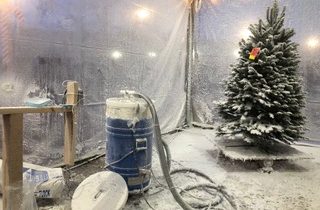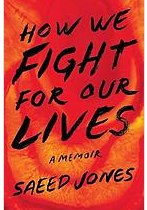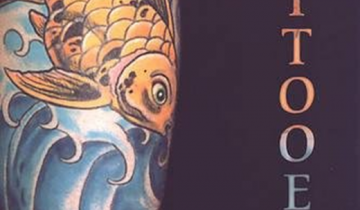LGBT Graphic Narratives Turn “Golden”
by Nel Ward
 During the last few years, graphic narratives, especially novels and memoirs, have expanded into a “Golden Age”¯ of LGBT graphic literary books, beginning with Alison Bechdel’s autobiographical Fun Home: A Family Tragicomic, published eight years ago by the mainstream press Houghton Mifflin. The growing importance of LGBT graphic narratives is demonstrated by Lambda Literary’s new category, Best Graphic Novel, after 25 years of Lammy awards in other literary genres. Last year, Lambda picked No Straight Lines: Four Decades of Queer Comics (annotated below) as best LGBT Anthology last year, the first time that a graphic novel succeeded in that division.
During the last few years, graphic narratives, especially novels and memoirs, have expanded into a “Golden Age”¯ of LGBT graphic literary books, beginning with Alison Bechdel’s autobiographical Fun Home: A Family Tragicomic, published eight years ago by the mainstream press Houghton Mifflin. The growing importance of LGBT graphic narratives is demonstrated by Lambda Literary’s new category, Best Graphic Novel, after 25 years of Lammy awards in other literary genres. Last year, Lambda picked No Straight Lines: Four Decades of Queer Comics (annotated below) as best LGBT Anthology last year, the first time that a graphic novel succeeded in that division.
The Band of Thebes website, which does an outstanding job of following the gay community throughout the arts, was especially enthusiastic about graphic bio finalist The Fifth Beatle: The Brian Epstein Story. Writer Vivek Tiwary, artist Andrew Robinson, and cartoonist Kyle Baker debuted the book in Italy before Dark Horse Comics published it in November 2013. The book’s title comes from the reference of “fifth Beatle” for the band’s manager after he discovered the band in Liverpool and became its driving force to worldwide success.
Another Lammy nominations is Alex Woolfson’s Artifice (AMW Comics) illustrated by Winona Nelson. The science-fiction novel follows the relationship of Deacon, the only android left on Da Vinci Four after he was sent there to eradicate the colonists, and lonely gay Jeff, the only remaining colonist. Originally a webcomic, the book, with its themes of isolation and humanity, was funded by the Kickstarter campaign. A third Lammy nominee, Calling Dr. Laura, is annotated below.
The most intriguing Lammy nominee, however, is J. Tana Ford’s Duck! Second Chances (Bang A Left). After learning that she was one of four nominees for this award, Ford wrote: “I cannot believe that a girl who worked alone in a chilly, spidery garage making comics about the Boston lesbian scene (albeit one that she loves with her whole heart) is in the same field as [Andrew Robinson]. It does feel a bit overwhelming. There are perhaps 100 copies of Duck Second Chances out in the world and that is it. All of which I made myself. From conception to writing to final inks and figuring out the publishing details–all of it. There was no Houghton Mifflin peeking in to see how things were coming along. No one to make fancy video reels previewing the book. Just me and Katie C (whom I cajoled to come in and please god edit the thing!).”¯
Advocate’s “five of the best LGBT graphic novels of the year”¯ selected by Jacob Anderson-Minshall has a different take on the “best.”¯ The only book from the Lammy awards that he includes is Artifice. One of his favorites is the young adult graphic novel from Jennie Wood, Flutter: Hell Can Wait (215 Ink), illustrated by Jeff McComsey. The plot follows 14-year-old shapeshifter, Lily, as she changes herself into a boy so that she can have a relationship with the girl she/he pursues.
I do disagree with Anderson-Minshall in his choice of Julie Maroh’s Blue is the Warmest Color (Arsenal Pulp Press), the graphic novel turned into the film that won last year’s Cannes film festival. Translated by Ivanka Hahnenberger, Blue’s maudlin story line of a high school junior lesbian and her affair with an older woman doesn’t live up to the fabulous illustrations.
Minshall-Anderson picked my favorite from the past couple of years. A finalist in last year’s Lambda Transgender Nonfiction category, Dylan Edwards’ Transposes (Northwest Press) uses six true stories of transgender to explore maleness. Funny, poignant, tragic, informativeā€”all these and more are embraced in the book. As Alison Bechdel wrote in her introduction to Edwards’ debut book:
“Seeing ourselves reflected accurately in the world is crucial to a sense of well-being, to feeling whole and real. The reflections of queer FTM experience that Edwards gives us here are sharply focused, delicately nuanced, and shot through with a warm humanity.”
Anderson-Minshall’s favorite “five”¯ are actually six. The other two are Anything That Loves and Julio’s Day, both annotated below.
The ALA/GLBTRT Over the Rainbow Committee (OTR), which selects the best of the year in LGBT books for adults, also noted the importance of graphic narratives through its inclusion of at least one title on its top ten since its inception in 2010, listing two in 2012.
2014: Anything That Loves: Comics Beyond “Gay” and “Straight” (Northwest Press), compiled by Zan Christensen, covering a wide range and nuances of bisexuality and the discrimination that bisexuals face from both the gay and straight communities.
2013: Are You My Mother? A Comic Drama (Houghton Mifflin Harcourt), Alison Bechdel’s sequel to Fun Home, complete with psychoanalysis and an in-depth look at Virginia Woolf’s To the Lighthouse.
2012: The Complete Wendell (Universe Publishing), a new edition of the Howard Cruse’s classic from the 1980s; and 4 + 4ever (Lethe Press), Ilike Merey’s story of an androgynous boy and a dyke girl in high school.
2011: Batwoman: Elegy (DC Comics), Greg Rucka’s tale of Kate Kane after the lesbian is thrown out of Westpoint before “Don’t Ask Don’t Tell” was overturned.
Some of my other favorite graphic narratives published during the last two years (* indicating inclusion on Over the Rainbow final lists):
Brad Bell & Jane Espenson. Husbands. (Dark Horse): A fun romp through diverse genre realms including superheroes, secret agents, Archie comics, and a Victorian drawing-room drama is initiated by a mystical wedding gift to newly married Brady Kelly and Cheeks.
*Nicole J. Georges. Calling Dr. Laura: A Graphic Memoir. (Houghton Mifflin): The author describes her pain-filled life finding acceptance as a lesbian in episodic vignettes starting when she was two and her mother told her that her father was dead and continuing as 23-year-old when a palm teller reveals that her father is actually alive. (Finalist for this year’s Lammy Graphic Novel award.)
*Gilbert Hernandez. Julio’s Day. (Fantagraphics): The gay experience has drastically changed over the past 100 years as shown through minimal text and bold black-and-white drawings. (One of Anderson-Minshall’s favorites.)
*No Straight Lines: Four Decades of Queer Comics. Ed. by Justin Hall. (Fantagraphic): Queer cartooners show four decades of a changing society as artists and writers outside the mainstream publishing world imaged an uncensored analysis of the LGBT community through underground comics and punk zines.
*Christy C. Road. Spit and Passion. (Feminist Press): A Cuban-American teenager follows her angst-filled journey toward acceptance as a lesbian through black and white drawings showing her fascination with punk rockers Green Day.
*David Wojnarowicz. 7 Miles A Second. Illus. by James Romberger and Marguerite Van CookĀ (Fantagraphics): Flamboyant art highlights this new edition of a 1996 combination of memoir and tirade about AIDS and the homophobia of the 1980s originally published four years after the author died of AIDS.
Zelman, David (Mohamed, Mohammed al-Muhammad & Youssef Fakish). Al-Quaeda’s Super Secret Weapon. (Northwest Press): When top-level jihadists see the repeal of “Don’t Ask, Don’t Tell”¯ as a way to destroy the U.S. armed forces and send an undercover gay man to learn about man-on-man love and sex, recruit Mahmoud learns only too well.
The rapid increase and variety of LGBT graphic narratives throughout the past few years has been enhanced by the Internet and the growth of self-publishing and small presses. Fantagraphics and Dark Horse have made LGBT graphic narratives available for several years, but a welcome addition to Northwest publishing is the press by the same name – Northwest Press.
And to start you off for 2014, there’s animator Diane Obomsawin’s On Loving Women (trans. by Helge Dascher, Drawn & Quarterly). The brief, true anecdotes of first love between women and the feelings that come up: fear, joy, irritation, awkwardness read like conversations. Although most of the vignettes are about adolescence, some occur during childhood, as young as six years old. The anthropomorphic figures provide a surreal humor that lightens the pathos of the stories, a perfect mix for tales of lesbian love. To top off the delight of this book, the bar code on the back is shaped like a heart. Watch GLBT Reviews for a complete review later this spring.
With so many available, I’ve missed many favorites from other people. To paraphrase Frank Zappa: So many LGBT graphic narratives, so little time!
Other sources:
http://www.advocate.com/holiday-gifts-everyone/2013/12/18/10-great-graphic-novel-gifts
http://www.npr.org/2013/02/20/172133247/beyond-visible-lgbt-characters-in-graphic-novels
http://lesbrary.com/tag/graphic-novels/
http://www.aadl.org/user/lists/33935
—Nel Ward, 4/17/14



[…] LGBT Graphic Narratives Turn “Golden” […]